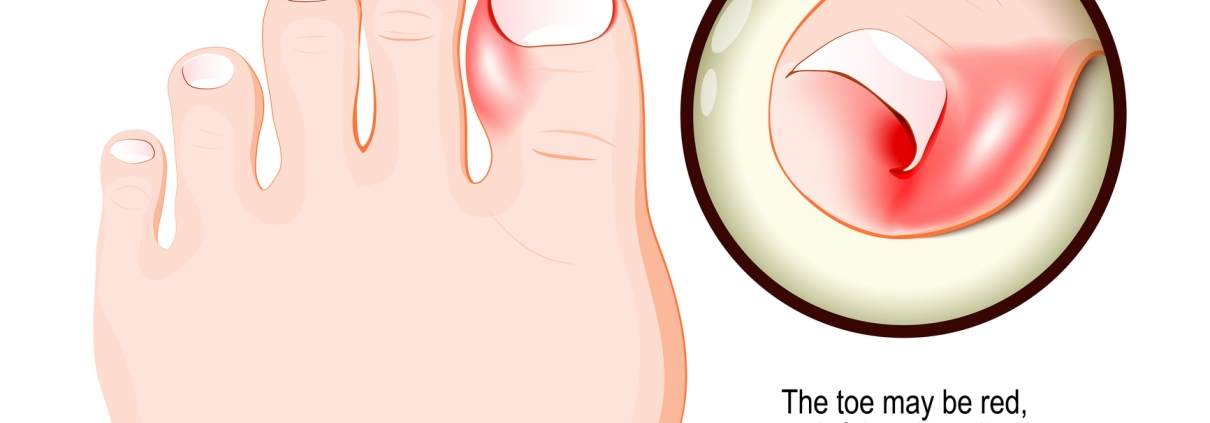Ingrown Toenails
Introduction
Ingrown toenails, or onychocryptosis, is a common and painful condition where the edge of the toenail grows into the surrounding skin. This condition can cause discomfort, swelling, and, in severe cases, infection. Most frequently affecting the big toe, ingrown toenails can interfere with daily activities such as walking and exercising.
This article will explore the causes, symptoms, prevention, and treatment options for ingrown toenails.
Causes of Ingrown Toenails
Several factors can contribute to the development of ingrown toenails, including:
Improper Nail Trimming: The most common cause of ingrown toenails is cutting the nails too short or rounding the edges. This encourages the nail to grow into the skin as it regrows.
Tight Footwear: Shoes that crowd the toes, especially narrow or ill-fitting ones, can force the toenail into the surrounding skin, increasing the risk of ingrowth.
Toe Injury: Trauma to the toenail, such as stubbing your toe, dropping something heavy on it, or repeated pressure (common in athletes), can cause the nail to grow abnormally.
Genetics: Some people have naturally curved nails that are more prone to becoming ingrown, making them genetically predisposed to the condition.
Poor Foot Hygiene: Not keeping your feet clean or dry can soften the skin and nails, making it easier for nails to penetrate the skin.
Fungal Infections: Toenail fungus can thicken and change the shape of the nail, making it more likely to become ingrown.
Symptoms of Ingrown Toenails
The symptoms of an ingrown toenail can range from mild discomfort to severe pain, depending on the stage of the condition. Common symptoms include:
Pain and Tenderness: The skin around the affected nail becomes sensitive and painful, especially when pressure is applied, such as when wearing shoes.
Redness and Swelling: The area around the ingrown toenail may become red, swollen, and inflamed as the nail irritates the surrounding skin.
Infection: If the ingrown toenail is not treated, it can lead to an infection. Signs of infection include increased redness, warmth, the presence of pus, and more intense pain.
Overgrowth of Skin: The skin surrounding the ingrown toenail may grow over the nail in response to the irritation, making the condition worse.
Treatment Options for Ingrown Toenails
Early-stage ingrown toenails can often be treated at home, but more advanced cases may require medical intervention. Here are some common treatment methods:
Home Remedies:
Soaking the Foot: Soaking the affected foot in warm, soapy water for 15–20 minutes, several times a day, can reduce swelling and soften the skin, making it easier for the nail to grow out.
Cotton or Dental Floss: After soaking, placing a small piece of cotton or dental floss under the edge of the nail can help lift the nail and encourage it to grow above the skin. Change the cotton or floss daily.
Topical Antibiotics: If there is mild infection or inflammation, applying an antibiotic ointment to the area can help prevent further infection.
Wearing Open-Toed Shoes: Giving your toes more room can reduce pressure and pain while the nail heals.
Medical Treatments:
Partial Nail Removal: If home treatments don’t work or the nail is severely ingrown, a doctor may recommend removing part of the nail. This procedure, done under local anesthesia, involves cutting away the part of the nail that is digging into the skin.
Nail Matrix Ablation: For recurring ingrown toenails, the doctor may remove part of the nail matrix (the root of the nail) to prevent the ingrown section from regrowing. This can be done chemically or surgically.
Antibiotics: In cases of infection, oral or topical antibiotics may be prescribed to treat the infection and promote healing.
Surgery: In extreme cases, where the ingrown toenail causes chronic pain or repeated infections, complete nail removal may be necessary. While the nail may regrow, this can prevent recurring issues in some cases.
Prevention of Ingrown Toenails
Preventing ingrown toenails is largely about proper foot care and hygiene. Here are some tips to avoid developing this painful condition:
Trim Nails Properly: Always cut toenails straight across, avoiding rounding or cutting them too short. The nail edge should be visible above the skin to prevent ingrowth.
Wear Comfortable Footwear: Choose shoes that fit well and have enough room in the toe box to avoid crowding or putting undue pressure on the toes.
Keep Feet Clean and Dry: Regularly wash and thoroughly dry your feet, especially after exercising or wearing closed shoes for long periods, to prevent fungal infections and soften nails.
Avoid Trauma to the Toe: Be cautious about activities that may lead to toenail injuries. Wearing protective shoes during heavy lifting or sports can help reduce the risk of trauma.
Treat Fungal Infections Early: Fungal infections can alter the shape and thickness of toenails, making them more likely to become ingrown. Early treatment of infections can prevent further issues.





